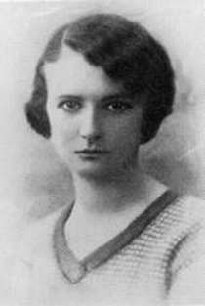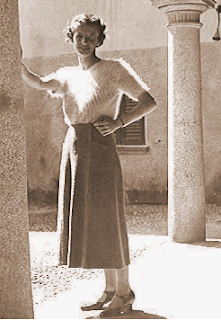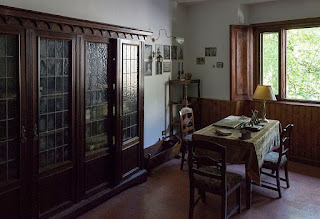Tragic writer whose work was published only after her death
 |
| Antonia Pozzi wrote more than 300 poems in her short life |
Born into a wealthy family, she enjoyed a privileged lifestyle but seemingly a difficult relationship with her parents. She kept diaries and began to write poems as a teenager, although none came to light until she died in tragic circumstances at the age of just 26.
Afterwards, her notebooks were found to contain more than 300 poems, which revealed her to be one of the most original voices in 20th century Italian literature. Most have subsequently been published, to great critical acclaim.
The daughter of Roberto Pozzi, a prominent Milan lawyer, and his aristocratic wife, Countess Lina Cavagna Sangiuliani, Antonia’s literary talent may have been inherited from her great-grandfather on her mother’s side, the 19th century poet and writer, Tommaso Grossi.
As a teenager, she had multiple interests, studying German, English and French and travelling both within Italy and further afield, to France, Austria, Germany, England, Greece and North Africa, always indulging her love of photography.
Friends said that she was never happier, though, than when she was at the family’s 18th century villa at Pasturo, a village that nestles at the foot of the Orobic Alps near Lecco, some 70km (43 miles) north of Milan. She would spend many hours cycling around local paths and her writing often made reference to the stark but beautiful mountain environment.
 |
| Pozzi pictured on the terrace of the family villa at Pasturo |
From high school, she enrolled at the University of Milan, studying modern philology. Her circle of friends there included the future poet Vittorio Sereni and the philosophers Enzo Paci and Luciano Anceschi. Her professors included Antonio Banfi, regarded as the most open and modern Italian university professor of the time, who would later become a Communist member of the Italian Senate.
Pozzi graduated in 1935, her degree awarded on the basis of her thesis on Gustave Flaubert, the French novelist.
Banfi had been a signatory to the Manifesto of Anti-Fascist Intellectuals and Pozzi herself became increasingly concerned about the political climate in Italy in the 1930s. Her father was a member of the Fascist Party, who made him mayor of a Lombardy village.
After graduating, she wrote for a magazine, Corrente, and took up a teaching position at a Milanese technical institute in 1937. She did social work as a volunteer, often assisting defendants in juvenile courts.
Sadly, the following year, her health began to decline. She had to undergo an operation to remove her appendix and her recovery was poor, causing her to develop repeated bouts of pneumonia.
It was on December 12 that year that she was found unconscious in a ditch in the grounds of the Abbey of Chiaravalle, in a southern suburb of Milan, in freezing, snowy conditions. She was taken to hospital but died the following day.
 |
| Antonia Pozzi's writing room at the Casa Pozzi has been kept as it was in her lifetime |
The first volume of Pozzi’s poetry was published in 1939 in a private edition, selected by her father, who altered or excluded anything he deemed to be inappropriate or that reflected badly on the family, although protecting his daughter’s reputation was also a likely motivation.
Expanded editions followed in the 1940s and again in the 1960s. Through diligent research, some of her admirers in the literary world would later track down copies of the poems Pozzi’s father changed so that the originals could be published as they were written.
Pozzi’s poetry sought, in her own words, ‘to reduce the weight of words to the minimum’ and had a deceptive simplicity. It perhaps reflected a mood among Italian artists, writers and even architects of her age to reject the grandiose in favour of minimalism.
One critic wrote of her work that ‘her Modernist verse is lyrical and experimental, pastoral and erotic, powerfully evoking the northern Italian landscape and her personal tragedies amid the repressive climate of Fascism’. She is today seen as one of the most important voices in Italian poetry in the 20th century.
.JPG) |
| The village of Pasturo can be found amid the beautiful scenery of Valsassina, north of Lecco |
In Pasturo, a village which sits in the Valsassina basin on the eastern slopes of the Grigna massif in the province of Lecco, the memory of Antonia Pozzi is preserved in a series of 22 wall panels mounted around the streets of the village centre, each bearing verses from her poetry or photographs she took of the village and the surrounding area. The family villa, in Via Alessandro Manzoni, is kept as a museum, which can be visited by groups of 10 by arrangement. The village, which has a population of just short of 2,000, is a starting point for many walking and climbing itineraries. The village is mentioned in Alessandro Manzoni’s classic novel I promessi sposi (The Betrothed) as a place to which one of the story’s central characters flees to escape the plague.
Find places to stay in Pasturo with Booking.com
 |
| The Chiostro della Ghiacciaia, which is part of the university's Ca' Granda complex |
The University of Milan, founded in 1924 with the merger of two older educational establishments, is one of the largest in Europe, with about 60,000 students and 2,000 permanent staff. Many of the university’s departments are housed in important historic buildings in the centre of Milan, including the Ca’ Granda, a monumental complex from the 15th century in Via Festa del Perdono at the heart of the historical city centre, the 18th-century Palazzo Greppi in Via Sant’Antonio, designed by the architect of Teatro alla Scala, Giuseppe Piermarini, and the 17th-century Collegio di Sant'Alessandro, commissioned by the Arcimboldi family. Ca' Granda was originally commissioned by Francesco I Sforza, the 15th century Duke of Milan, and his wife, Bianca Maria Visconti, who wanted to create a hospital for the poor.
More reading:
How Andrea Zanzotto drew inspiration from Veneto landscapes
The civil engineer who became a Nobel Prize-winning poet
Dario Fo - the outspoken genius whose work put spotlight on corruption
Also on this day:
1539: The death of influential marchioness Isabella d’Este
1571: The death of Renaissance sculptor Benvenuto Cellini
1816: Fire damages Teatro di San Carlo
1960: The birth of football referee Pierluigi Collina
(Picture credit: Antonia Pozzi's writing room by Xavier Caré; Pasturo landcape by Ago76; Chiostro della Ghiacciaia by Giovanni Dall'Orto; all via Wikimedia Commons)
No comments:
Post a Comment